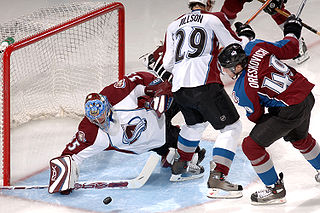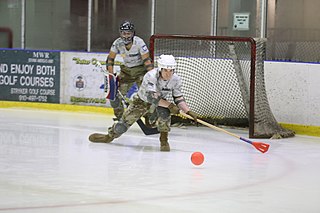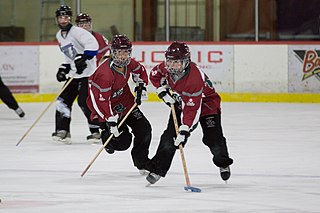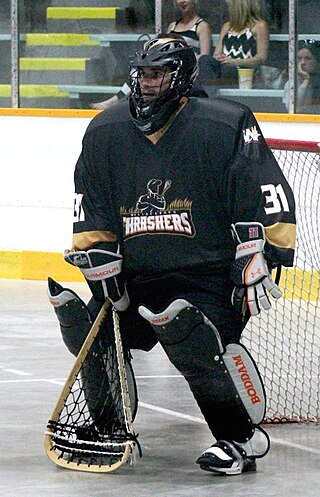
In many team sports that involve scoring goals, the goalkeeper is a designated player charged with directly preventing the opposing team from scoring by blocking or intercepting opposing shots on goal. Such positions exist in bandy, rink bandy, camogie, association football, Gaelic football, international rules football, floorball, handball, hurling, field hockey, ice hockey, roller hockey, lacrosse, ringette, rinkball, water polo, and shinty, as well as in other sports.

In ice hockey, the goaltender is the player responsible for preventing the hockey puck from entering their own team's net, thus preventing the opposing team from scoring. The goaltender mostly plays in or near the area in front of the net, called the goal crease. Goaltenders tend to stay at or beyond the top of the crease to cut down on the angle of shots. In the modern age of goaltending there are two common styles, butterfly and hybrid. Because of the power of shots, the goaltender wears special equipment to protect the body from direct impact.

A penalty in ice hockey is a punishment for an infringement of the rules. Most penalties are enforced by sending the offending player to a penalty box for a set number of minutes. During the penalty the player may not participate in play. Penalties are called and enforced by the referee, or in some cases, the linesman. The offending team may not replace the player on the ice, leaving them short-handed as opposed to full strength. When the opposing team is said to be on a power play, they will have one more player on the ice than the short-handed team. The short-handed team is said to be "on the penalty kill" until the penalty expires and the penalized player returns to play. While standards vary somewhat between leagues, most leagues recognize several common varieties of penalties, as well as common infractions.

A goaltender mask, commonly referred to as a goalie mask, is a mask worn by goaltenders in a variety of sports to protect the head and face from injury from the ball or puck, as they constantly face incoming shots on goal. Some sports requiring their use include ice hockey, lacrosse, inline hockey, field hockey, rink hockey, ringette, bandy, rinkball, broomball, and floorball. This article deals chiefly with the goal masks used in ice hockey.

Broomball is a both a recreational and organized competitive winter team sport played on ice or snow and is played either indoors or outdoors, depending on climate and location. It is a ball sport and is most popularly played in Canada and the United States.

A baseball glove or mitt is a large glove worn by baseball players of the defending team, which assists players in catching and fielding balls hit by a batter or thrown by a teammate. Gloves are traditionally made of leather; but today other options exist, such as PVC and synthetic leather.

There are two styles of gloves worn by ice hockey players. Skaters wear similar gloves on each hand, while goaltenders wear gloves of different types on each hand.

Inline hockey or roller hockey is a variant of hockey played on a hard, smooth surface, with players using inline skates to move and ice hockey sticks to shoot a hard, plastic puck into their opponent's goal to score points. The sport is a very fast-paced and free-flowing game and is considered a contact sport, but body checking is prohibited. There are five players including the goalkeeper from each team on the rink at a time, while teams normally consist of 16 players. There are professional leagues, one of which is the National Roller Hockey League (NRHL). While it is not a contact sport, there are exceptions, i.e. the NRHL involves fighting.

In ice hockey, the goaltender wears specialized goaltending equipment to protect themselves from the impact of the puck, and to assist in making saves. Ringette and rinkball goaltenders use the same equipment with some exceptions. This article deals chiefly with the sport of ice hockey.

In ice hockey, butterfly style is a technique of goaltending distinguished by the goaltender guarding the lower part of the net by dropping to the knees to block attempts to score. The butterfly style derives its name from the resemblance of the spread goal pads and hands to a butterfly's wings. The butterfly style is contrasted with stand-up style, where most shots on a goal are stopped with the goaltender on his feet.
This is a list of common terms used in the sport of ice hockey along with the definitions of these terms.
Foot hockey is a sport related to hockey in which the only equipment is a ball, most commonly a tennis ball, that is kicked about the playing surface by the players in an attempt to score a goal on the opposing goaltender. It has been described as a "combination of hockey, soccer and handball" and "a form of soccer with a tennis ball". Foot hockey is played indoors or outdoors; footwear is optional indoors, but must be worn by either all or none of the players. It may be unisex or coed. Participation in foot hockey produced fewer catastrophic injuries than other winter sports in studies from 1986 to 1995.

Ringette is a winter team sport played on an ice rink using ice hockey skates, straight sticks with drag-tips, and a blue, rubber, pneumatic ring designed for use on ice surfaces. While the sport was originally created exclusively for female competitors, it has expanded to now include participants of all gender identities. Although ringette looks ice hockey-like and is played on ice hockey rinks, the sport has its own lines and markings, and its offensive and defensive play bear a closer resemblance to lacrosse or basketball.

Ball hockey is a team sport and an off-ice variant of the sport of ice hockey. The sport is also a variant of one of several floor hockey game codes; more specifically, it is a variant of street hockey.

In ice hockey, players use specialized equipment both to facilitate the play of the game and for protection as this is a sport where injuries are common, therefore, all players are encouraged to protect their bodies from bruises and severe fractures.

Lacrosse gloves are heavily padded, protective gloves worn by men's lacrosse players. The gloves are designed to protect players' hands, wrists, and forearms from checks, or legal defensive hitting common in the sport. Gloves consist of thick padding on the back of the hand and forearm covered in leather or canvas material, and a palm area made of synthetic and mesh material. A goaltender's gloves may have extra padding for the thumb to protect against injury from shots. While NCAA collegiate rules require that men's gloves have palms covered, other leagues, including post-collegiate club lacrosse, the National Lacrosse League, Major League Lacrosse, and international play, permit players to cut out the palm area for greater grip and control of the lacrosse stick.

In ice hockey and association football, a goaltender is credited with a save when they prevent a shot by the opponent from entering the net. A goaltender's efficiency in stopping shots, the save percentage, is calculated as a percentage of shots stopped divided by the total number of shots on goal. If a goaltender makes all the saves within a game it is called a shutout. In association football this is called a clean sheet.

Pads are a type of protective equipment used in a number of sports and serve to protect the legs from the impact of a hard ball, puck, or other object of play travelling at high speed which could otherwise cause injuries to the lower legs. These are used by batters in the sport of cricket, catchers in the sports of baseball and fastpitch softball, and by goaltenders in sports such as ice hockey, ringette, bandy, rinkball, field hockey, rink hockey and box lacrosse.

A trapper, also referred to as catch glove or simply glove, is a piece of equipment that an ice hockey goaltender wears on the non-dominant hand to assist in catching and stopping the puck.

The goaltender or goalie is a playing position in indoor or box lacrosse. More heavily armoured than a field lacrosse goaltender, since the invent of indoor lacrosse in 1931, the box lacrosse goalie has evolved into a much different position than its field lacrosse cousin.

















